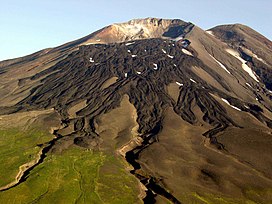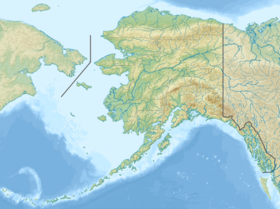Mount Gareloi
| Mount Gareloi | |
|---|---|
 Summit of the volcano | |
| Highest point | |
| Elevation | 5,161 ft (1,573 m)[1] |
| Prominence | 5,161 ft (1,573 m)[1] |
| Listing |
|
| Coordinates | 51°47′18″N 178°47′39″W / 51.78833°N 178.79417°W[1] |
| Geography | |
| Location | Gareloi Island, Alaska, U.S. |
| Parent range | Aleutian Islands |
| Geology | |
| Age of rock | Holocene-Pleistocene |
| Mountain type | Stratovolcano |
| Volcanic arc/belt | Aleutian Arc |
| Last eruption | August 1989 |
Mount Gareloi, or Gareloi Volcano, is a
The volcano is 6 miles (10 km) by 5 miles (8 km) at its base, possessing two summits. The southern crater is far greater in size, 984 feet (300 m) wide with fumaroles, which can be attributed to edifice failure in the southern wall, while Gareloi's northern crater is enclosed.
Discovery and accessibility
Gareloi Island is uninhabited and is part of the Alaska Maritime National Wildlife Refuge managed by the U.S. Fish and Wildlife Service.[5]
Geography and geology
Gareloi is the northernmost volcano of the

Gareloi is of lava flows and
There are two large lava valleys on the island's southwest side which are u-shaped. The oldest of these flows are of Pleistocene age composed of
Rock
The rock that makes up Gareloi Island and its volcano is estimated to be of Pleistocene age.
Mapping
The Alaska Volcano Observatory proceeded to map the volcano and its surrounding area in 2003,[10] in addition to implementing seismic monitors in June.[11]
Eruptive history
Gareloi has an extensive eruptive history, dating back to at least 1760. At least 12 eruptions have occurred at the summit, accompanied by lava and
1929
In 1929, Mount Gareloi underwent a major
1980s–1990s
On August 8, 1980 Gareloi erupted for the first time in records since 1929, sending ash plumes over 35,000 feet (10,668 m) into the atmosphere.
Threat
Proximal volcanic hazards pose a significant threat to human life near Gareloi. If Gareloi were to erupt unexpectedly, ash clouds, falling volcanic ash, pyroclastic flows, and debris avalanches (such as lahars) could easily spawn deadly hazards such as tsunamis. As volcanic ash can induce engine failure, it puts commercial airplanes in particular at high risk.[14] Inhalation of volcanic ash, also known as tephra, creates respiratory complexities and irritation of the eye.[15]
Pyroclastic flows from an eruption would destroy much wildlife about the volcano. Gareloi has historically produced several pyroclastic flows, which can travel extremely fast. Future flows at Mount Gareloi could travel off the island into the Pacific Ocean and, if large enough, could fall into the ocean and generate tsunamis, though unlikely.[15]
See also
- List of mountain peaks of North America
- List of Ultras of the United States
- List of volcanoes in the United States
References
- ^ a b c "Alaska & Hawaii P1500s - the Ultras". Peaklist.org. Retrieved 2013-01-31.
- ^ Alaska Volcano Observatory, Volcano Information -- Gareloi, Retrieved Dec. 16, 2022.
- ^
Chisholm, Hugh (1910). The Encyclopædia Britannica. Vol. 3. London. p. 775.
{{cite encyclopedia}}: Missing or empty|title=(help)CS1 maint: location missing publisher (link) - ^ Coombs, McGimsey and Browne, page 1.
- ^ Preliminary Volcano-Hazard Assessment for Gareloi Volcano, Gareloi Island, Alaska
- ^ a b Brandon Browne; Coombs, Michelle L.; Larsen, J. "Preliminary Geology of Gareloi Volcano, Western Aleutian Islands (Alaska)". United States Geological Survey. Archived from the original on March 15, 2009. Retrieved May 3, 2009.
- ^ a b c "Gareloi description and statistics". Alaska Volcano Observatory. Retrieved April 15, 2009.
- ^ a b c d "Gareloi". Global Volcanism Program. Smithsonian Institution. Retrieved April 13, 2009.
- ^ a b c d Coombs, McGimsey and Browne, page 9.
- ^ "Gareloi geologic, topographic, and location maps, as well as references that are classified as maps or that contain maps". Alaska Volcano Observatory. Retrieved May 3, 2009.
- ^ Neal, McGimsey, Dixon and Melnikov, page 1.
- ^ "Gareloi, Aleutian Islands, Alaska". Volcano World. Retrieved May 5, 2009.
- ^ a b c Coombs, McGimsey and Browne, page 8.
- ^ Coombs, McGimsey and Browne, page 14.
- ^ a b Coombs, McGimsey and Browne, page 15.
Sources
- Coombs, Michelle L.; McGimsey, Robert G.; Browne, Brandon L. (2008). "Preliminary Volcano-Hazard Assessment for Gareloi Volcano, Gareloi Island, Alaska" (PDF). Scientific Investigations Report 2008–5159. United States Geological Survey. Retrieved April 19, 2009.
{{cite journal}}: Cite journal requires|journal=(help) - Neal, Christina A.; McGimsey, Robert G.; Dixon, Jim; Melnikov, Dmitry (2005). "2004 Volcanic Activity in Alaska and Kamchatka: Summary of Events and Response of the Alaska Volcano Observatory". Open-File Report 2005-1308. United States Geological Survey. Retrieved May 3, 2009.
{{cite journal}}: Cite journal requires|journal=(help) - Wood, Charles Arthur; Kienle, Jürgen (1992). Volcanoes of North America. Cambridge University Press.
External links


